On the Road is a weekday feature spotlighting reader photo submissions.
From the exotic to the familiar, whether you’re traveling or in your own backyard, we would love to see the world through your eyes.
We start with lots of colorful birds from Albatrossity today, and we spend the rest of the week back in Kenya with way2blue, finishing up his series.
Albatrossity
Our time at Lake Manyara was winding down, and we needed to get on the way to the crater, but there were a few sights and critters seen as we headed out.
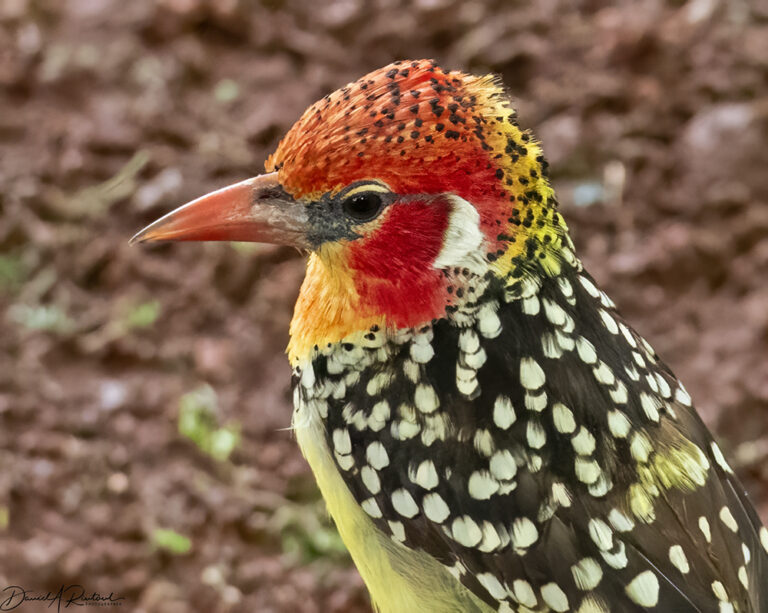
We’d seen the Red-and-yellow Barbet (Trachyphonus erythrocephalus) a few days earlier, but it was great to see them again at our lunch spot. Very colorful, like most of the family, and that erythrocephalus epithet is certainly accurate! Click here for larger image.
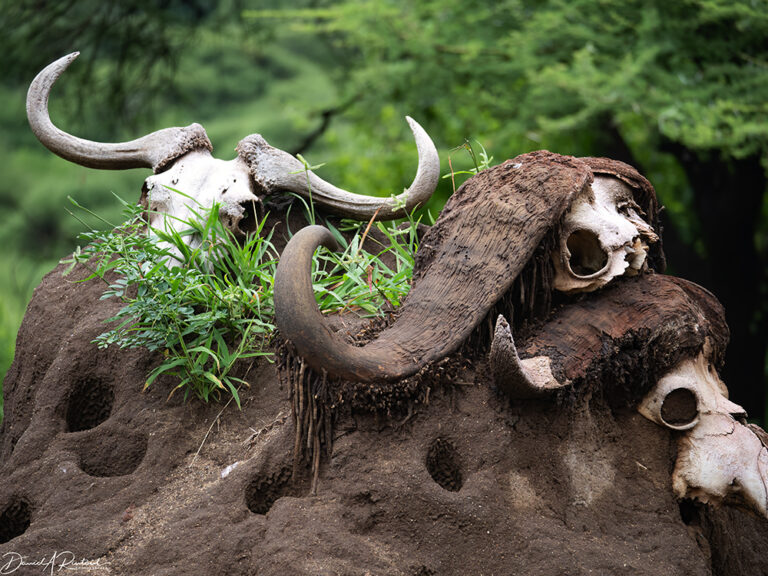
The lunch spot also featured this termite mound decorated with Cape Buffalo skulls. I think Georgia O’Keefe would have appreciated the style. Click here for larger image.
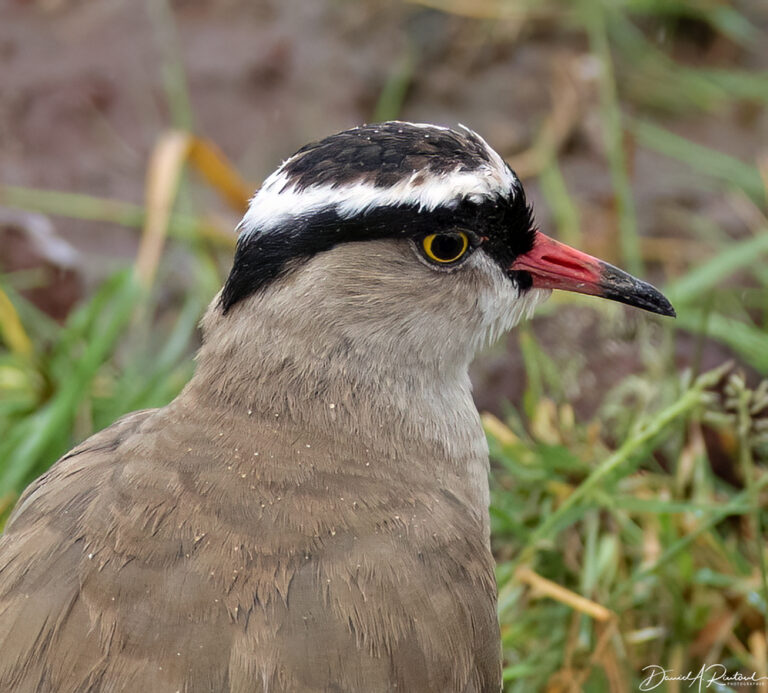
Another lapwing! You would have thought that we had exhausted the lapwing list last week, but here was another. The Crowned Lapwing (Vanellus coronatus) is a handsome critter, with a monk-like tonsure and bright red bill. It is apparently much more common in southern Africa, but common enough in parts of Tanzania that we saw them several times. And don’t worry, there are still more lapwings to come in future weeks! Click here for larger image.
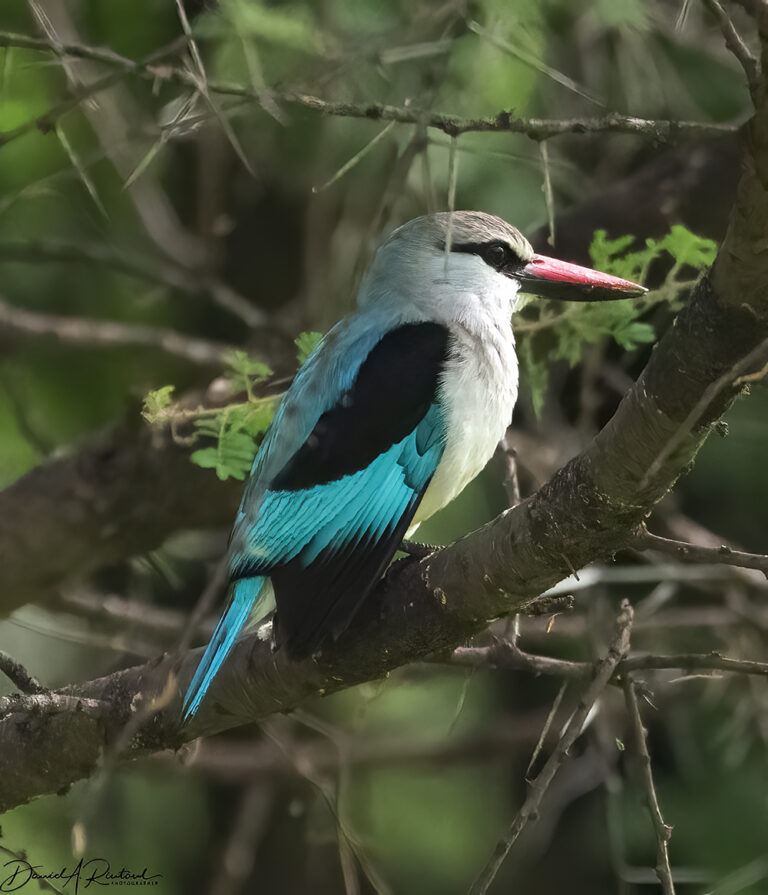
Kingfishers are a widespread and diverse group, and come in an astonishing variety of sizes and colors. This Woodland Kingfisher (Halcyon senegalensis) is widespread in sub-Saharan Africa, but not particularly common in Tanzania. That soft blue and gray ensemble makes it a particularly lovely kingfisher, in my opinion. Click here for larger image.

A much more common bird, the Grey Heron (Ardea cinerea) is found not only in Africa, but all across Eurasia, from Britain to Borneo. It is very similar to our familiar North American Great Blue Heron (A. herodias), but the sharp-eyed among you would have already noticed at least one big difference. The North American bird has chestnut-colored thighs, and this one, true to its name, has grey thighs. Click here for larger image.
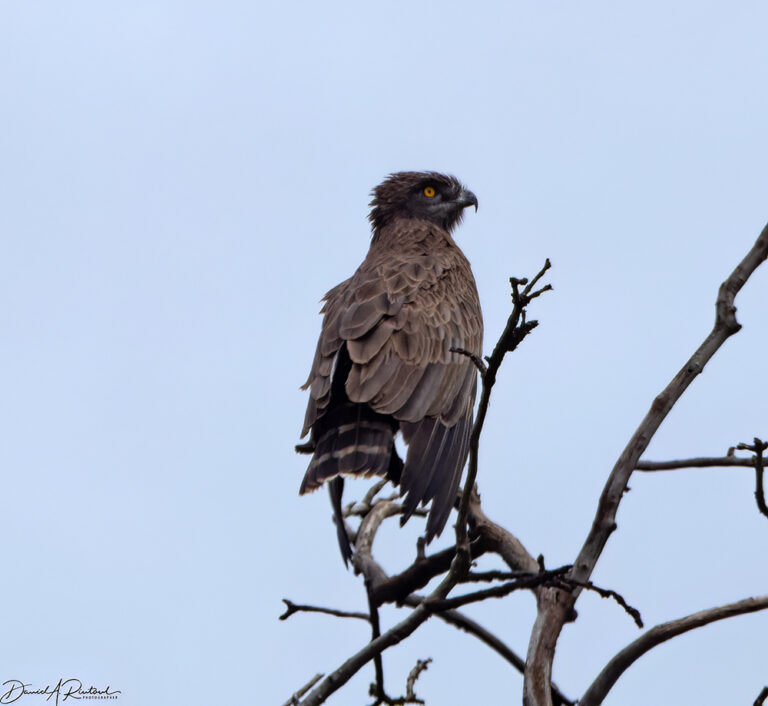
A bird that I’d hoped we’d see (and really hoped that it would be closer than this distant shot), this Brown Snake-Eagle (Circaetus cinereus) was perched a fair number of meters from the road. But you can still see that piercing yellow eye, even at that distance. True to their name, they consume mostly snakes, including the venomous ones, so they get a lot of respect, at least from me. Click here for larger image.
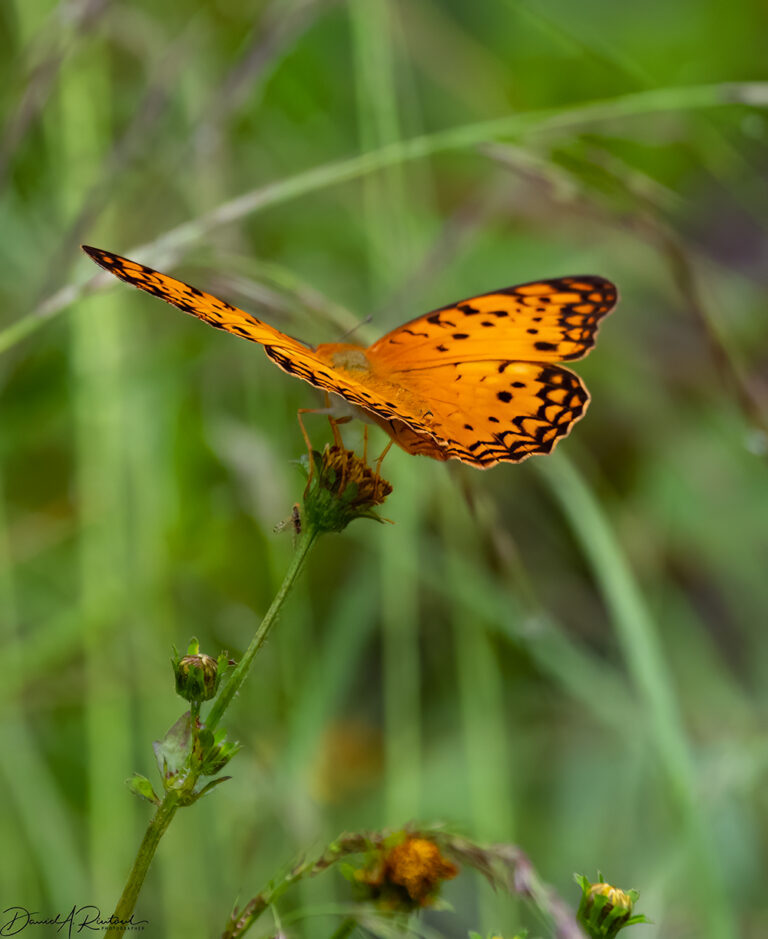
Not a bird, but more colorful than a Snake-Eagle, this is the Common Leopard (Phalanta phalantha), also known as the Spotted Rustic. Found in Asia as well as Africa, it is described as “sun-loving”, but we saw this one on a rainy overcast day nonetheless. Click here for larger image.
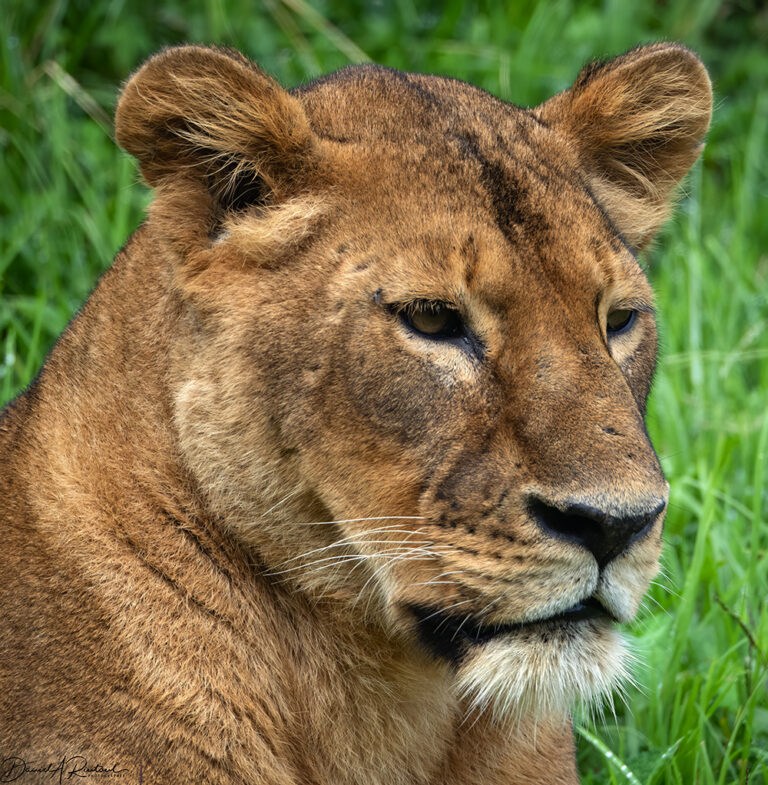
In our first two days in Tanzania, we did not see lions (Panthera leo). There are apparently lots of lions in Tanagire, and very few cheetah, but when we were there we saw cheetahs and no lions. So this lioness was our first encounter with this iconic African species, on the road along the rim of Ngorongoro Crater. She consented to pose for us, and we went on our way. We would see many more lions in the days ahead. Click here for larger image.
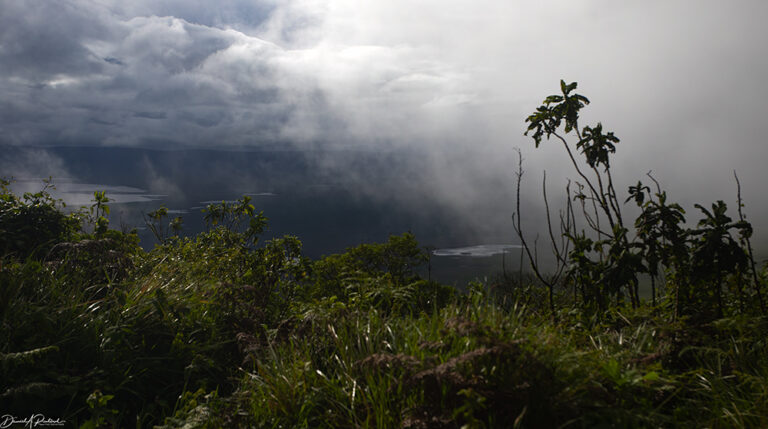
View from the crater rim. The Ngorongoro Crater is a large caldera, formed when a very large volcano erupted and collapsed into itself about 3 million years ago. The crater floor is about 100 square miles in area, and the crater walls rise up steeply for about 2000 ft from the floor, which is already at about 6000 ft above sea level. It contains several small lakes, and a lot of habitat and critters. Click here for larger image.
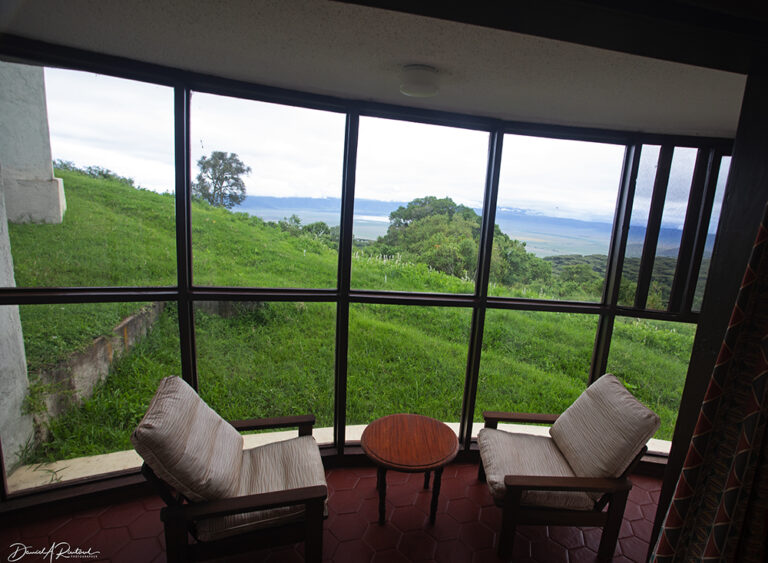
But before we could see those critters, we hauled up for the evening at a lodge perched on the crater rim. Luxurious, and very welcome. I admit I was actually sore (especially my tailbone) after a day of sitting in a vehicle, bouncing along very rough and muddy roads. After a beer and a good dinner, I was down for the count! Click here for larger image.

Paul in Jacksonville
How do Cape Buffalo skulls come to rest on a termite mound?
Deputinize Eurasia from the Kuriles to St Petersburg
@Paul in Jacksonville:
…they’re there as a warning from the termites to anything that might think about rooting around for a termite dinner….
Deputinize Eurasia from the Kuriles to St Petersburg
To the OP – VERY cool. Ngorongoro has been on my list of wants for a while. It’s where we all came from – the mothership, so to speak.
We hit Zambia, Botswana and SA back in 2018, mostly on photo safaris. In April, we’re going to Capetown, the Winelands and Kruger – I’m promised that our days in Kruger will be as fantastic as our experiences the last time.
SteveinPHX
Thank you for wonderful photos. Love the Kingfisher photo. Had no idea there were such varieties in that bird.
JeanneT
I always sigh over the lovely bird photos, but the portrait of that lioness is grand!
YY_Sima Qian
Lovely photos!
stinger
Here, kitty kitty, nice kitty!
eclare
mvr
@eclare: Yes, I thought that too.
mvr
Thanks for these!
The snake-eagle looks impressive. I imagine they must have to be taught how to catch poisonous snakes in order to stay safe. I guess they could practice on non-poisonous snakes, but still it seems like a dangerous thing to learn to do.
Albatrossity
@Paul in Jacksonville: Termites probably ordered them from Amazon. Or Wayfair.
Albatrossity
@mvr: I think that they are mostly “taught” to avoid the head end until they have pinned it down with their talons. Would work with any snake, venomous or not. Here’s a short video of this.
Steve in the ATL
@Deputinize Eurasia from the Kuriles to St Petersburg: Cape Town is probably my favorite place in the world. We last did the Winelands in 2019—am concerned that many did not survive Covid.
pieceofpeace
My appreciation to look up and admire those flying birds that swoop and climb with speed and grace, often while ‘talking,’ has, over the years, been enhanced by your photos.
For the first time, termites have built their own mini-pyramids in my house, but I’ll forgo letting it get much larger…
WaterGirl
I 💕 the Kingfisher! Seeing your photo of the mist prompts me to ask… I would be happy to see a whole post of photos that don’t even include birds or animals! :-)
Albatrossity
@WaterGirl: I have some of those. Not a lot, however. I will try to add at least one or two general landscape looks in future posts. But be forewarned, some of them will have animals in them!
J R in WV
I love all these photos, even the ones without critters in them. Lodge looks comfortable! Crater looks mysteriously misty, like a Fantasy about traveling back in time 3,000,000 years…
Thanks as always for the great photo set! Kingfisher is wonderful I grew up in the woods on a dry ridgetop in So. WV. So didn’t see a kingfisher until we moved to our place in Lincoln county WV, where there are creeks with shiners, and Great Blue Herons and Kingfishers. Wood ducks also too !!
mvr
@Albatrossity: Thanks for the film!
Still seems dangerous. And yet the eagle seems almost relaxed.
StringOnAStick
I’m always excited when I see a post from you, and my excitement is always rewarded. Thanks again.
Yutsano
You know what they say about redheads…and that particular redhead is stunning! And oh yeah the lioness just casually posing…
cope
Thank you for showing us these wonderful pictures. It’s highly doubtful I’ll ever get to go to Africa so I appreciate how well your pictures give a sense of the differentness of the place.
Thanks again.
Albatrossity
@cope: Thanks. But if you love in the Great Plains, it’s not that much different, at least at some levels. Sure, we don’t have elephants and lions here, but the feel of that open plain and the vast sky, coupled with some similar birdsongs, made it feel like home to me.
And indeed, it is our home, for all of us.